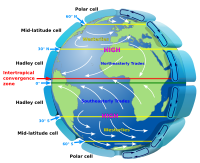
Photo from wikipedia
Surface engineering is a promising strategy to limit or prevent the formation of biofilms. The use of topographic cues to influence early stages of biofilm formationn has been explored, yet… Click to show full abstract
Surface engineering is a promising strategy to limit or prevent the formation of biofilms. The use of topographic cues to influence early stages of biofilm formationn has been explored, yet many fundamental questions remain unanswered. In this work, we develop a topological model supported by direct experimental evidence, which is able to explain the effect of local topography on the fate of bacterial micro-colonies of Staphylococcus spp. We demonstrate how topological memory at the single-cell level, characteristic of this genus of Gram-positive bacteria, can be exploited to influence the architecture of micro-colonies and the average number of surface anchoring points over nano-patterned surfaces, formed by vertically aligned silicon nanowire arrays that can be reliably produced on a commercial scale, providing an excellent platform to investigate the effect of topography on the early stages of Staphylococcus spp. colonisation. The surfaces are not intrinsically antimicrobial, yet they delivered a topography-based bacteriostatic effect and a significant disruption of the local morphology of micro-colonies at the surface. The insights from this work could open new avenues towards designed technologies for biofilm engineering and prevention, based on surface topography.
Journal Title: Nanomaterials
Year Published: 2022
Link to full text (if available)
Share on Social Media: Sign Up to like & get
recommendations!